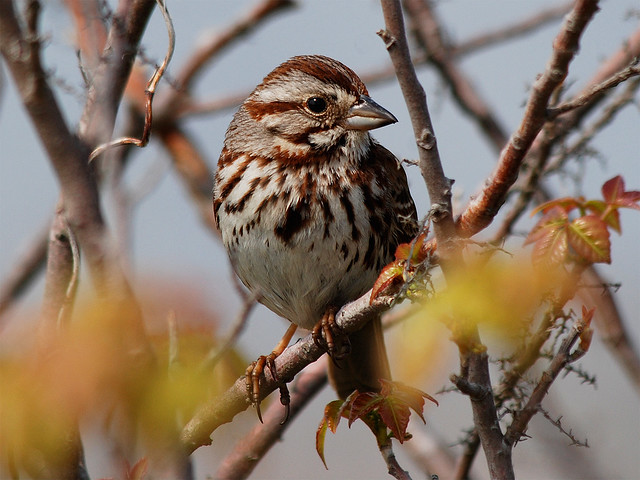I'm reading a book* on (the phyla of) all the world's animals, that opines that birds are the best way to get into natural history: they are interesting, beautiful, and everywhere, and there are a small enough number of species that it is possible to learn all the species of birds in an area.
I entered natural history through plants. Identifying plants is much easier than identifying birds in at least one way: they don't run away when you approach them. You can also take bits of them home for a better look without doing permanent harm.
I have tried without success to learn to identify birds by their songs. Such skill brings enormous advantage: no more sneaking around staring upward and trying to get enough of a glimpse of a bird hidden among the foliage to identify it (in my case, usually necessitating a photo and much time spent with a guide book). My old friend is a serious birder, and identifies birds by their songs as she walks, usually without need for even a glance. Unfortunately, she lives at the other end of the country. So I've listened to Audubon teaching CDs of birdsongs. I've listened to Cornell Lab of Ornithology recordings of birds I already know live in the neighborhood. I've listened to birds and recorded birds and then tried to match them with Roger Tory Peterson's "sonograms." But somehow I just can't make the learning stick. Over and over I have painstakingly identified a bird I heard, only to find it is a familiar species with a song I should know immediately. --all despite having a pretty good ear for music, and long experience in singing, myself.
So I was hopeful when I discovered that iNaturalist has a feature that allows uploading sound files. Could I upload birdsong? Would birders bother listening to them? (It takes much, much longer to listen to a 30 second recording than to glance at a photo.) A few days ago I found a few recordings from last year in my phone, uploaded them to SoundCloud as required, and created "observations." Then I went away, expecting to wait days or weeks for a response.
Instead it took less than an hour! Two different birders had listened to my recordings and confidently ventured IDs for half of them, somewhat less confidently for the rest. And they also pointed out the likely identities of others birds audible in the background! I will be adding song sparrows, yellow warblers and killdeer to the short list of birds I know in the neighborhood.
My years of being handicapped when it comes to birds are coming to an end! I look forward to walking the dogs with phone in hand, and to recording the riotous chorus of birds next spring, and maybe even to going out early to catch the dawn chorus.
I entered natural history through plants. Identifying plants is much easier than identifying birds in at least one way: they don't run away when you approach them. You can also take bits of them home for a better look without doing permanent harm.
I have tried without success to learn to identify birds by their songs. Such skill brings enormous advantage: no more sneaking around staring upward and trying to get enough of a glimpse of a bird hidden among the foliage to identify it (in my case, usually necessitating a photo and much time spent with a guide book). My old friend is a serious birder, and identifies birds by their songs as she walks, usually without need for even a glance. Unfortunately, she lives at the other end of the country. So I've listened to Audubon teaching CDs of birdsongs. I've listened to Cornell Lab of Ornithology recordings of birds I already know live in the neighborhood. I've listened to birds and recorded birds and then tried to match them with Roger Tory Peterson's "sonograms." But somehow I just can't make the learning stick. Over and over I have painstakingly identified a bird I heard, only to find it is a familiar species with a song I should know immediately. --all despite having a pretty good ear for music, and long experience in singing, myself.
So I was hopeful when I discovered that iNaturalist has a feature that allows uploading sound files. Could I upload birdsong? Would birders bother listening to them? (It takes much, much longer to listen to a 30 second recording than to glance at a photo.) A few days ago I found a few recordings from last year in my phone, uploaded them to SoundCloud as required, and created "observations." Then I went away, expecting to wait days or weeks for a response.
Instead it took less than an hour! Two different birders had listened to my recordings and confidently ventured IDs for half of them, somewhat less confidently for the rest. And they also pointed out the likely identities of others birds audible in the background! I will be adding song sparrows, yellow warblers and killdeer to the short list of birds I know in the neighborhood.
My years of being handicapped when it comes to birds are coming to an end! I look forward to walking the dogs with phone in hand, and to recording the riotous chorus of birds next spring, and maybe even to going out early to catch the dawn chorus.

Song sparrow.
_-Santa_Cruz_-Puerto_Ayorto_c.jpg) |
| Yellow warbler. |

Killdeer.
*Ten Million Aliens by Simon Barnes I came across it in a bookstore on Martha's Vineyard two years ago and saved my pennies 'til I could afford the ebook version.

